ミッシングウェッジ(ミッシングコーン)
ミッシングウェッジ(ミッシングコーン)
missing wedge (missing cone)
[目次:試料室]
トモグラフィーのための傾斜シリーズ画像を取得するとき、試料ホルダーの傾斜角が制限されているために、試料の画像が得られない角度領域のこと。
ミッシングウェッジは、試料の三次元構造を再構成する際にアーティファクトの原因になる。精度の高い三次元構造の構築には、ミッシングウェッジを小さくすることが重要である。通常のホルダーの傾斜角は±30°程度に制限されているが、高傾斜用試料ホルダーでは、±70°程度まで試料を傾斜することができる。
トモグラフィーで傾斜シリーズ画像を取得するには高傾斜用試料ホルダーが用いられる。
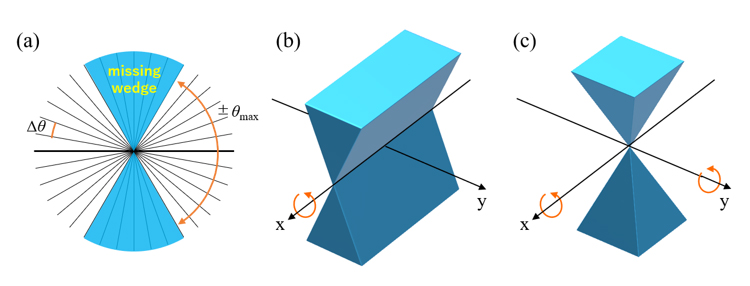
図1 (a)傾斜シリーズ画像を取得する場合のミッシンングウェッジの模式図。傾斜角範囲±θmax、角度ステップΔθ。
(b)一軸傾斜および(c)二軸傾斜の場合のミッシングウェッジの形状。一軸傾斜ではゴニオメーターのx軸のみを傾斜軸とし、二軸傾斜ではx軸とy軸の両方を傾斜軸として傾斜シリーズ画像を取得する。二軸傾斜の方がミッシングウェッジがより小さい(得られる角度情報が多い)ため、アーティファクトの少ない三次元構造を得ることができる。
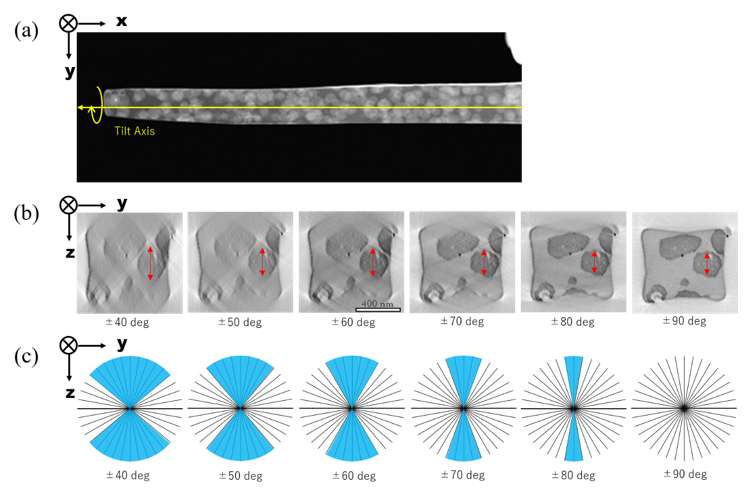
図2 (a)柱状に加工した高分子試料の暗視野-STEM像。
(b)(a)の試料のx軸回転の一軸傾斜画像シリーズから三次元再構成によって得られた構造の断面像に発生したミッシングウェッジによるアーティファクト。傾斜角度範囲が狭くなるほど、電子線の入射方向であるz方向の分解能が低下する(具体的には、赤い矢印で示すように内部の粒子が伸びて見える)。 このz方向の分解能の低下は、三次元測長(体積、表面積、アスペクト比)の精度を下げる原因となる。
(c)ミッシングウェッジの模式図。ミッシングウェッジは図中に青色で示している。
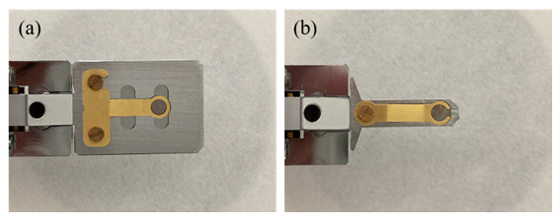
図3 (a)通常の一軸傾斜試料ホルダーと(b)高傾斜用試料ホルダー
"Missing Wedge" means an angle region where the image of a specimen cannot be obtained due to the limited tilt angle of the specimen holder when acquiring tilt-series images for tomography.
The Missing Wedge causes the artifacts when reconstructing the three-dimensional (3D) structure of the specimen. To reconstruct a high-accuracy 3D structure, it is important to decrease the Missing Wedge. The tilt angle of an ordinary holder is limited to about ±30°, but a high-tilt specimen holder can tilt the specimen up to about ±70°.
Thus, the high-tilt specimen holder is used for tomography.
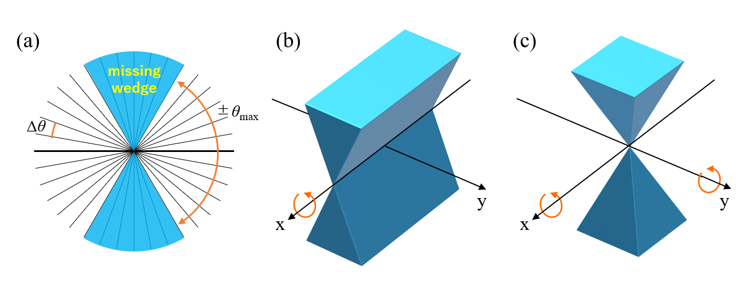
Fig. 1(a) Schematic of Missing Wedge for acquiring tilt-series images with the tilt-angle range of ±θmax and the angle step of Δθ.
(b) Shapes of Missing Wedge for a uniaxial-tilt specimen holder. (c) Shapes of Missing Wedge for a double-tilt specimen holder.
When using a uniaxial-tilt specimen holder, the specimen images are taken by tilting the specimen only about the X axis. Whereas, when using the double-tilt holder, the images are taken by tilting the specimen about both of the X and Y axes.
Since the double-tilt holder achieves a smaller Missing Wedge than the uniaxial-tilt holder, the use of the double-tilt holder provides a 3D reconstructed structure with less artifacts.

Fig. 2 (a) Dark field-STEM image of a high-polymer specimen subjected to pillar-shaped milling.
(b) Artifacts due to the Missing Wedge appeared in the cross-sectional images of the structure obtained by 3D reconstruction from a uniaxial-tilt (about X-axis) series images of the specimen. As the tilt range becomes narrower, the resolution in the Z direction degrades. That is, the particles in the specimen are seen to elongate in the incidence direction of the electron beam (as indicated by the red arrow in each image (b)).
This degradation of resolution in the Z direction causes a decrease in accuracy of 3D metrological analysis (volume, surface area, aspect ratio).
(c) Schematic of the Missing Wedge indicated by blue color.
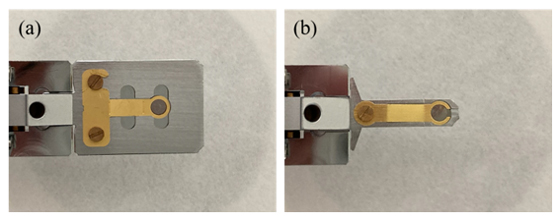
Fig. 3(a) Ordinary uniaxial-tilt specimen holder and (b) High-tilt specimen holder.
関連用語から探す
説明に「ミッシングウェッジ(ミッシングコーン)」が含まれている用語






